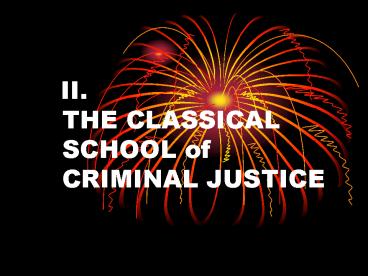II' THE CLASSICAL SCHOOL of CRIMINAL JUSTICE - PowerPoint PPT Presentation
1 / 15
Title:
II' THE CLASSICAL SCHOOL of CRIMINAL JUSTICE
Description:
2. definition: a positive OR negative act or. omission ... The Leviathan. 1) humans are inherently afraid. of each other. 2) creation of a society based ... – PowerPoint PPT presentation
Number of Views:59
Avg rating:3.0/5.0
Title: II' THE CLASSICAL SCHOOL of CRIMINAL JUSTICE
1
II. THE CLASSICAL SCHOOL of
CRIMINAL JUSTICE
2
A. Introduction
- 1. is crime universal?
- a. is there anyone not touched by
crime? - b. Is a crime always a crime?
- 2. definition a positive OR negative
act or - omission
prohibited by law, and in - violation of
the penal code - 3. crime is that which arouses our
- indignation (Pound, 1930)
- 4. what is the most appropriate way to
- understand crime?
3
B. A Historical Perspective
- 1. crime is created and established by
- those who make the Law
- 2. rise of the city-state
- gt Rome / Athens crime by
proclamation - 3. church-based definitions (the Middle
Ages) - a) demonic possession
- b) dramatization of evil
- 4. rise of republicanism in the last
(20th) century - a) Holocaust
- b) genocide across the globe
4
- 5. practical example
- gt MURDER
- 1) (def) the UNLAWFUL killing of
a - human being by
another - with malice
aforethought - either expressed or
implied - 2) Qs Is the killing of another
moral or immoral? - 6. does morality (or ethics) have anything
to do with - crime commission or creation?
- 7. is harm relevant?
- gt mala in se v mala prohibitum
5
- 10. A Crime Solution Model
- Criminological
Criminal Justice - Questions Questions
CRIME
Why Who Where What
Who Why Where When How Now what
6
(No Transcript)
7
Genesis of the Classical School
- 1. Crime thinking and and Modern Legal
Definitions - gt 1600s through 1700s
- 1) emergence of state rule over
the church - gt with vestiges of mans
(peoples) Fall from - Grace
- 2) recognition that prevailing
justice systems were - cruel, capricious, and
arbitrary - 3) fair / just systems of
prosecution / punishment - should be responsible
societal goals - 4) first
intellectual consideration of the criminal - 5) underlying premise
offenders have the ability to - reason and make rational
decisions
8
- 6) crime control requires clear
- definitions /
explanations of - offenses, minimal
judicial - discretion, and quick /
certain - punishments
- 7) crime cannot exist without
law, - and law must be based
on the - recognition of injury
/ harm to - the individual and
society - 2. contributors
- a. Thomas Hobbes (1588-1679)
- The Leviathan
- 1) humans are inherently
afraid - of each other
- 2) creation of a society
based
9
- b. Jean Jacques Rousseau
- (1712-1778)
- 1) society is corrupt and
- brings out the inherent
- evil in people
- 2) social institutions,
such as - governments, are
necessary to - control human
emotion, sexual political, - and egotistic drive
- 3) social contracts are
constructed to - create laws that
protect and control - citizens and
demonstrate the will of - the people
10
- c. Jeremy Bentham
- (1748-1832)
- 1) utilitarianism
- 2) pleasure-pain principle
- 3) the panopticon
11
(No Transcript)
12
- d. Cesare Beccaria (1738-1794)
- 1) On Crimes and
Punishment - (1809)
- 2) crime as law must
reflect - the will of the State
- 3) crime must be based on
categories of harm - a) most serious
crimes against the state - b) most prevalent
crimes that injure / - affect the of
and / or the property of - individuals
- c) most recognized
crimes that affect the - \ public peace
13
- 3. contributions of Classical School
- philosophy to contemporary
- U.S. criminal justice
- a. stare decisis let the
decision - stand
- 1) an act cannot be held
criminal unless it has - previously previously
be adjudicated illegal - 2) case law precedence
- b. res judicata a thing has
been decided - gt double jeopardy
provision - c. no decision should be based
on a cruel and - unusual punishment
14
- f. philosophy of the presumption
- of innocence
- g. advocacy of incarceration as
- punishment
- h. harshness of life imprisonment
- i. fatuousness of capital
punishment - 4. enduring scientific legacy
- a. debate between voluntarism
(free-will) vs - determinism
(pre-destination) - b. Deterrence Theory (Zimring and
Hawkins, - 1973)
- 1) based on Benthamian
utilitarianism /
15
- 2) types
- a individual /
specific - b general
- c. Rational Choice Theory
- Derek Cornish (Cornish and Clarke, 1985)
- 1) crime lifes
experiences, individual - morality,
self- esteem / concept, - wants /
desires, levels of -
gratification - 2) decision to commit
precedes decision on - what to commit
- 3) different crimes based on
different decisions































